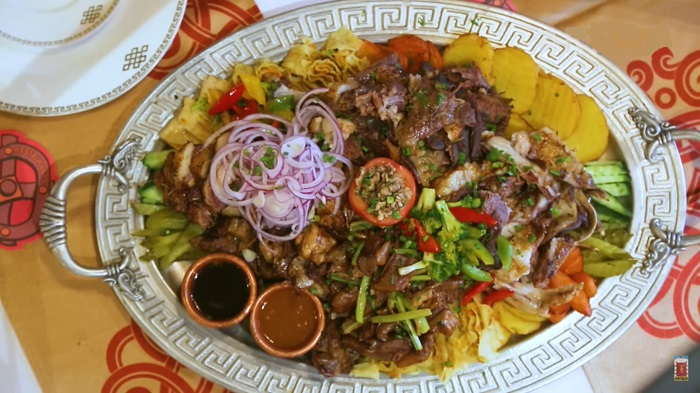Mongolian cuisine stands out as a testament to the country’s rich nomadic heritage and its unique relationship with its natural environment. At the heart of Mongolian culinary tradition lies a deep connection with the diverse ecosystems that sustain its nomadic animal habitats. In this article, we will delve into the intricate interplay between Mongolian cuisine and the vast steppes, deserts, and mountain ranges that serve as the backdrop for nomadic herding life.
Nomadic Animal Habitats: Mongolia’s expansive landscapes, ranging from rolling grasslands to rugged mountains and arid deserts, provide the ideal habitat for nomadic pastoralism. Nomadic herders, known as “khalkh,” have roamed these vast territories for centuries, tending to their livestock and following seasonal migration patterns in search of grazing pastures. The nomadic lifestyle is deeply rooted in the culture and traditions of Mongolia, with the well-being of animals intricately intertwined with the survival of the herding communities.
The livestock that roam Mongolia’s vast steppes include horses, sheep, goats, cattle, and camels, each playing a vital role in the nomadic way of life. Horses are prized for their speed and agility, serving as essential companions for herders and providing transportation across the vast expanses of the Mongolian landscape. Sheep and goats are valued for their wool, meat, and milk, while cattle and camels offer additional resources such as meat, milk, and hides.
Traditional Mongolian Cuisine: Mongolian cuisine is characterized by its simplicity, emphasizing the use of locally sourced ingredients and traditional cooking methods. Meat, particularly from livestock such as sheep, goats, and horses, forms the cornerstone of Mongolian diet, reflecting the nomadic lifestyle of the people. The harsh climate and rugged terrain have influenced the culinary traditions of Mongolia, resulting in hearty and flavorful dishes that provide sustenance and warmth to herders and their families.
One iconic Mongolian dish is “buuz,” steamed dumplings filled with minced meat (often mutton or beef), onions, and spices. Buuz are a popular snack and are traditionally eaten during festive occasions such as Tsagaan Sar (Lunar New Year). Another beloved dish is “khorkhog,” a traditional Mongolian barbecue prepared by cooking meat, usually mutton or goat, with vegetables and hot stones in a sealed container. This method of cooking results in tender and flavorful meat infused with the smoky aroma of the hot stones.
Other traditional dishes include “borts,” air-dried meat that serves as a staple food for nomadic herders, providing sustenance during long journeys and harsh winters. Dairy products such as airag (fermented mare’s milk), aaruul (dried curd), and tsotsgii (clotted cream) are also essential components of the Mongolian diet, known collectively as “tsagaan idee” or white food.

https://www.youtube.com/watch?v=6Z-nk_Ub2EQ
Sustainable Practices and Conservation: Mongolian nomadic herders have developed sustainable practices that promote the conservation of natural resources and the preservation of biodiversity. These practices are deeply rooted in traditional ecological knowledge and are passed down through generations of herders. Some key sustainable practices include:
- Rotational Grazing: Nomadic herders practice rotational grazing, moving their livestock across different pastures to prevent overgrazing and soil degradation. This allows grasslands to recover and regenerate, promoting the health of ecosystems and ensuring the long-term sustainability of grazing lands.
- Livestock Diversity: Mongolian herders maintain a diverse range of livestock species, including sheep, goats, cattle, horses, and camels. This diversity of species helps to balance grazing patterns and ensures resilience against environmental fluctuations such as droughts and harsh winters.
- Traditional Land Management: Traditional ecological knowledge guides herders in sustainable land management practices, including water conservation, pasture restoration, and wildlife habitat protection. Herders understand the importance of maintaining healthy ecosystems for the well-being of their livestock and communities.
- Conservation Initiatives: Government and non-governmental organizations in Mongolia are implementing conservation initiatives to protect critical habitats, preserve endangered species, and promote sustainable livelihoods for nomadic communities. These initiatives include the establishment of protected areas, habitat restoration projects, and community-based conservation programs.
Conclusion: The unique relationship between Mongolian cuisine and its nomadic animal habitats reflects the deep cultural heritage and sustainable practices of the country’s nomadic herders. Through traditional dishes and culinary traditions, Mongolian cuisine celebrates the bounty of the land and the resilience of its people. As Mongolia continues to navigate modernization and environmental challenges, preserving this unique culinary heritage and promoting sustainable practices are essential for the well-being of both people and the planet. By honoring the symbiotic relationship between humans, animals, and the natural environment, Mongolia can continue to thrive as a land of rich cultural diversity and ecological abundance.

